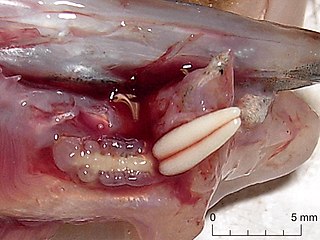 W
WAcanthochondria is a genus of copepods, containing the following species:
 W
WAcanthochondria limandae is a species of copepods in the genus Acanthochondria. They are host-specific ectoparasites of two species of flatfish: the common dab and the European flounder. They attach themselves to the bases of the gill arches of their hosts. They can infest as much as 2 to 30% of fish in a given population.
 W
WAcartia clausi is a species of marine copepod belonging to the family Acartiidae. This species was previously thought to have a worldwide distribution but recent research has restricted its range to coastal regions of the north-east Atlantic Ocean as far north as Iceland, the Mediterranean Sea and the Black Sea, with specimens from other regions assigned to different species.
 W
WAcartiidae is a family of calanoid copepods distinguishable by the rostral margin not being extended. They are epipelagic, planktonic animals, not being found below a depth of 500 metres (1,600 ft). There are over 100 described species distributed throughout the world's oceans, mainly in temperate areas.
 W
WAfrocyclops pauliani is an extinct species of copepod in the family Cyclopidae. A single specimen was discovered in 1951 in a small freshwater pool near Antananarivo, Madagascar, but the species has not been seen in collections since.
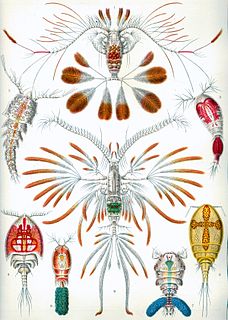 W
WArtotrogidae is a family of copepods in the order Siphonostomatoida.
 W
WCalanidae is the largest taxonomic family of calanoid copepods. It includes the genus Calanus, which may be the most abundant metazoan genus on Earth.
 W
WCalanoida is an order of copepods, a group of arthropods commonly found as zooplankton. The order includes around 46 families with about 1800 species of both marine and freshwater copepods between them. Calanoid copepods are the dominant animals in the plankton in many parts of the world's oceans, making up 55%–95% of plankton samples. They are therefore important in many food webs, taking in energy from phytoplankton and algae and 'repackaging' it for consumption by higher trophic level predators. Many commercial fish are dependent on calanoid copepods for diet in either their larval or adult forms. Baleen whales such as bowhead whales, sei whales, right whales and fin whales rely substantially on calanoid copepods as a food source.
 W
WCalanus is a genus of marine copepod in the family Calanidae. The genus was split in 1974, with some species being placed in a new genus, Neocalanus. The following species are recognised:
 W
WCalocalanus is a genus of copepods, the only genus in the family Calocalanidae:
 W
WCalocalanus pavo is a species of copepod in the family Calocalanidae.
 W
WCanthocamptidae is a family of copepods. Most of the 700 species are confined to fresh water, although there are also marine species. It contains the following genera:
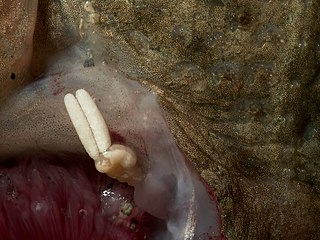 W
WChondracanthidae is a family of parasitic copepods, usually found infecting the branchial chamber of demersal fishes. It comprises the following genera:
 W
WClausidiidae is a family of parasitic copepods of the suborder Poecilostomatoida, containing the following genera:
 W
WClausidium is a genus of copepods that have been found in subtopical to temperate coastal areas along the Pacific, Atlantic and Gulf coasts of North America, the Pacific and Atlantic Coasts of South America, the Atlantic and Mediterranean coasts of Europe, the Atlantic coast of Africa, and the coast of India.
 W
WCryptopontius is a genus of copepods in the family Artotrogidae.
 W
WThe Cyclopidae are a family of copepods containing more than half of the 1,200 species in the order Cyclopoida in over 70 genera.
 W
WCyclopinodes elegans is a species of marine copepods in the family Cyclopinidae. It is found in Scotland.
 W
WCyclops strenuus (Fisher) is a common species of copepod in small water bodies in central Europe.
 W
WDiacyclops is a genus of cyclopoid copepods in the family Cyclopidae. There are more than 120 described species in Diacyclops.
 W
WDiacyclops thomasi is a species of cyclopoid copepod in the family Cyclopidae.
 W
WDiaptomus is a genus of copepods with a single eye spot. It is superficially similar in size and appearance to Cyclops. However it has characteristically very long first antennae that exceed the body length. In addition, the females carry the eggs in a single sac rather than the twin sacs seen in Cyclops. It is a copepod of larger freshwater lakes and still waters.
 W
WEctinosomatidae is a family of the Harpacticoida, a huge group of crustaceans belonging to the subclass Copepoda. Like most of their relatives, they are usually benthic inhabitants of marine environments. Ectinosomatidae commonly inhabit sediment and fragments of dead corals or glass sponges, and occasionally algae and bryozoans, in the deep oceans. In the epifaunal species, the first leg pair is often modified to allow the animals a better grip on the substrate.
 W
WEpischura is a genus of copepods in the family Temoridae, containing the following species:Epischura fluviatilis Herrick, 1883 Epischura lacustris S. A. Forbes, 1882 Epischura massachusettsensis Pearse, 1906 Epischura nevadensis Lilljeborg, 1889 Epischura nordenskioldi Lilljeborg, 1889 Epischura smirnovi Borutsky, 1961 Epischura udylensis Borutsky, 1947 Epischura vagans Pickering, 1844
 W
WEpischurella baikalensis is a species of copepod in family Temoridae. It is endemic to Lake Baikal, being the dominant zooplankton species there: 80%–90% of total biomass. It measures 1.5–2 mm (0.06–0.08 in).
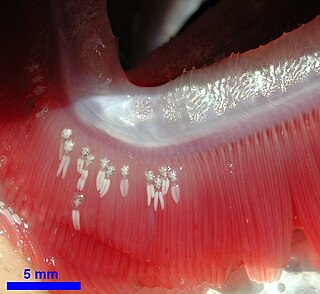 W
WErgasilus is a genus of copepod crustaceans occurring in both the ocean and fresh water, often called gill lice. The females are parasitic upon the gills of fishes. Being copepods, gill lice have a single median eye on their head. The second antennae are modified into prehensile pincers. Male gill lice are free-living.
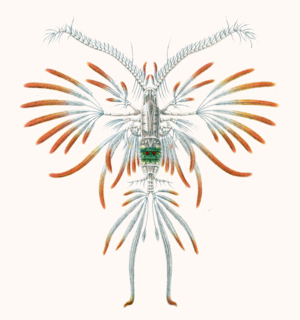 W
WEuaugaptilus is a genus of copepods.
 W
WEudiaptomus is a genus of freshwater crustaceans in the family Diaptomidae. It contains the following species:
 W
WEurytemora is a genus of copepods in the family Temoridae. The World Register of Marine Species lists the following species:
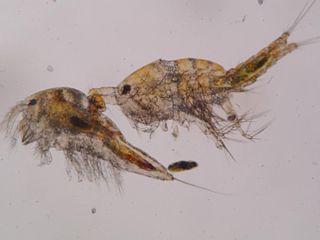 W
WHarpacticidae is a family of copepods, containing the following genera:
 W
WLepeophtheirus is a genus of sea lice. The best-known species is L. salmonis, the salmon louse. Other species include L. pectoralis, which uses flatfish as its host, particularly the European flounder, and is also the type species of the genus Lepeophtheirus.
 W
WLepeophtheirus elegans is a species of sea lice.
 W
WLeptodiaptomus ashlandi is a calanoid copepod zooplankton native to the Laurentian Great Lakes and their basin.
 W
WLernaeocera is a genus of marine copepods in the family Pennellidae, containing the following species:
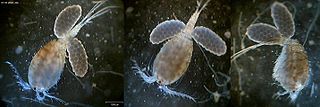 W
WMacrocyclops is a genus of copepods belonging to the family Cyclopidae. There are currently 13 described species found in fresh water habitats throughout the world:
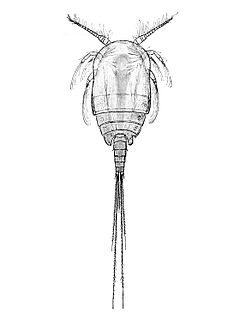 W
WMisophrioida is an order of copepods, containing the following families:Misophriidae Boxshall & Jaume, 2000 Palpophriidae Boxshall & Jaume, 2000 Speleophriidae Boxshall & Jaume, 2000
 W
WMonstrilla is a genus of copepods in the family Monstrillidae.
 W
WMormonillidae is a family of planktonic marine copepods, the only member of the order Mormonilloida. There are five known species in two genera:Mormonilla Giesbrecht, 1891Mormonilla atlantica Wolfenden, 1905 Mormonilla phasma Giesbrecht, 1891Neomormonilla Ivanenko & Defaye, 2006Neomormonilla extremata Ivanenko & Defaye, 2006 Neomormonilla minor (Giesbrecht, 1891) Neomormonilla polaris (G. O. Sars, 1900)
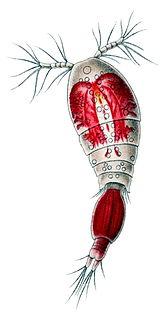 W
WOncaea is a genus of copepods. The genus contains bioluminescent species. Unlike other bioluminescent copepods, Oncaea have an internal (non-secreted) bioluminescence. Oncaea contains the following species:
 W
WOncaea venusta is a species of copepod with a cosmopolitan distribution, but lacking from the Arctic Ocean. Females are 1.1–1.3 mm (0.043–0.051 in) long, while males are only 0.8–1.0 mm (0.031–0.039 in) long. The front of the head is unusually wide, and the body is brightly coloured, usually yellow–orange, but sometimes red. O. venusta feeds on a variety of zooplankton and phytoplankton.
 W
WOncaeidae is a family of copepods, containing the following genera:Archioncaea Böttger-Schnack & Huys, 1997 Conaea Giesbrecht, 1891 Epicalymma Heron, 1977 Monothula Böttger-Schnack & Huys, 2001 Oncaea Philippi, 1843 Spinoncaea Böttger-Schnack, 2003 Triconia Böttger-Schnack, 1999
 W
WParacalanidae is a family of Calanoid copepods, consisting of the following genera:Acrocalanus Giesbrecht, 1888 Bestiolina Andronov, 1991 Delibus Vives & Shmelava, 2007 Paracalanus Boeck, 1865 Parvocalanus Andronov, 1970 Pseudoparacalanus Robinson, 1948
 W
WPeniculus is a genus of marine copepods in the family Pennellidae.
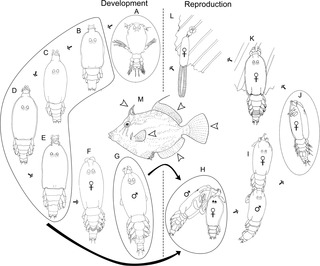 W
WPeniculus minuticaudae is a species of parasitic pennellid copepod. It has been described in 1956, redescribed in 2012, and its complete life cycle has been elucidated on the cultured threadsail filefish, Stephanolepis cirrhifer in 2013.
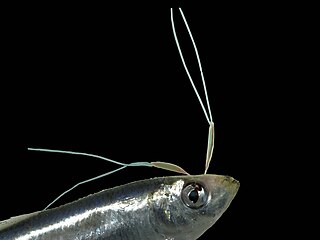 W
WPennellidae is a family of copepods, containing numerous genera, including:
 W
WProtosarcotretes is a genus of marine copepods in the family Pennellidae. Its type-species is Protosarcotretes nishikawai. This genus exhibits the most plesiomorphic states in the first to fourth legs of pennellids, and is differentiated from two closely related pennellid genera Sarcotretes and Lernaeenicus by the morphology of the oral appendages.
 W
WSapphirina, also called the sea sapphires, is a genus of parasitic copepod, containing the following species:
 W
WSapphirina darwinii is a species of parasitic copepod. It is widespread and common in the Indian Ocean, and reaches a maximum length of 2.8 millimetres (0.11 in).
 W
WSapphirinidae is a family of parasitic copepods, containing the following genera:
 W
WSiphonostomatoida is an order of copepods, containing around 75% of all the copepods that parasitise fishes. Their success has been linked to their possession of siphon-like mandibles and of a "frontal filament" to aid attachment to their hosts. Most are marine, but a few live in fresh water. There are 39 recognised families:
 W
WTegastidae is a family of copepods, which are characterised by having laterally compressed bodies, a claw-like mandible in the nauplius stage, and by a modified male genital complex. 85 species have been described in 6 genera. Two species of Smacigastes are found at hydrothermal vents, while the remaining species are found in shallow water, associated with algae, bryozoans and cnidarians, such as corals.
 W
WTemora is a genus of copepods in the family Temoridae. The World Register of Marine Species lists the following species:Temora discaudata Giesbrecht, 1889 Temora kerguelensis Wolfenden, 1911 Temora longicornis (Müller O.F., 1785) Temora stylifera (Dana, 1849) Temora turbinata (Dana, 1849)
 W
WTemoridae is a family of copepods, containing the following genera:Epischura S. A. Forbes, 1882 Epischurella Smirnov, 1936 Eurytemora Giesbrecht, 1881 Ganchosia Oliveira, 1946 Heterocope G. O. Sars, 1863 Lahmeyeria Oliveira, 1946 Temora Baird, 1850
 W
WThermocyclops is a genus of crustacean in family Cyclopidae. It was first described and later extensively researched by Friedrich Kiefer, who discovered some 20 species. The species and subspecies of the genus inhabit fresh and brackish waters alike all around the world, although most are from tropical areas.
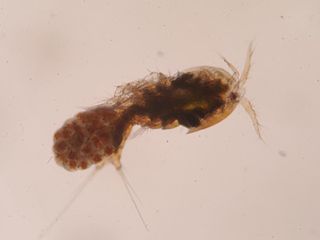 W
WTigriopus is a genus of copepods in the family Harpacticidae, containing the following species: